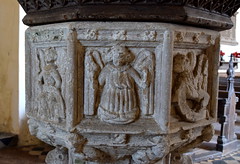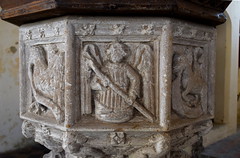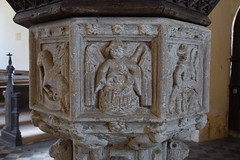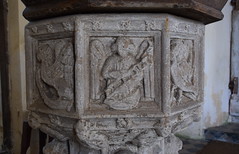| |
|
St
George, Shimpling From the little redundant church at Frenze
on the outskirts of Diss it is not much more than a mile
in a straight line across the fields to Shimpling church,
but in the furnace-heat of this early August day it took
three miles of cycling along doglegging lanes for me to
reach it. These are very lonely lanes, protected from the
A140 and any through traffic intending on reaching Diss
any time soon. I don't think I passed a single car, and
the only people I saw were a couple of walkers, a man and
woman with rucksacks and staves. We said hello, and I
headed past never expecting to see them again.
Eventually I reached the track down to Shimpling church
and freewheeled down to the churchyard, and as I opened
the gate the walkers came up beside the hedge, to meet
me, having trudged across the fields. They were very
nice, both with that slight air of hippydom which they
had obviously acquired at the time in the sixties and
never lost, something perhaps easier to maintain in rural
East Anglia than in some big city. They lived locally,
and like me had just come from Frenze church. They sat in
the churchyard to rest, and I went inside.
I remembered the first time I'd come this way, in early
2005 on a day of sub-zero temperatures, snow on the
ground and more snow to come. That day, it seemed a
silent, frozen space, remote from any century as much as
from any place. And yet the tower of St George is a
familiar sight to drivers between Ipswich and Norwich,
off in the fields near Dickleburgh. A substantial,
landmark church then, but it may surprise you to learn
that it is redundant. Shimpling's redundancy seems
careless. Unlike Frenze church, which has just a
farmhouse for company, St George does not sit in a a tiny
village, and if drawn into a group with Dickleburgh could
surely have sustained a monthly service or so. Probably,
if it arose nowadays, St George would not be declared
redundant. From the point of view of the building, of
course, it was both a blessing and a mercy, for as at
nearby Frenze the church is now in the capable, caring
hands of the Churches Conservation Trust where it was
previously prey to neglect.
For many years this church has been kept locked, and you
had to go and get a key for it. I had found this a
frustrating experience, for on three occasions I had
found the keyholder out. Nowadays the church is open
every day, although the 'church open' sign, which in this
case might have been useful out on the track, was
cunningly concealed in the porch. Maybe the CCT are still
a bit wary, but a notice on the board told me that if I
found the church difficult to access I should call the
CCT office in Cambridge, something I hadn't seen before.
We are not very far from the border after all, and St
George is perhaps more typical of Suffolk than Norfolk, a
small, rural church made opulent by the wealth of the
later years of the 15th century. It was then that the
font came, and the benches, the roof, the surviving
scattering of medieval angel glass. Otherwise, the
feeling is of the much-maligned Victorians, who loved
churches and wanted this one restored to its former
glory. Geoffrey Millard, rector through those times, has
his memorial in the chancel, but all around it is the
building that he would recognise instantly if he stepped
into it today.
The font is a very good and typical example of the late
medieval East Anglian style. On the panels, the symbols
of the four evangelists are interspersed with four angels
holding the Instruments of the Passion, a crown of
thorns, a ladder, a lance, and what was probably three
nails.
   
Amber
light fills the space beneath the tower, and I was glad I
was here again, in this silent space, this touchstone to
the long generations. There are curiosities: under the
benches at the west end, there is a trap door.
Underneath, some of the original medieval tiles have
survived the Victorians, who merely built a wooden
platform over them. Then, a wholly secular brass
inscription of 1598 to Anthony le Grys is set in the
middle of the nave - but the inlay is the wrong size and
shape, and so it may have come originally from somewhere
else. Or was the original stolen and this replacement
hastily prepared in later, less articulate times, perhaps
the middle of the 17th Century? It struck me coming back
that Anthony le Grys was probably a child.
A small hole in the north wall of the sanctuary is surely
too tiny to have been an aumbry. And yet, it is set back
to take a door, and appears once to have had some sort of
wooden tympanum set over it. Could it have been a squint
from a shrine chapel? Or even from an anchorite's cell?
Incidentally, another curious thing: There is a Shimpling
in Suffolk as well, and the churches of both are
dedicated to St George, an otherwise unusual East Anglian
dedication. The reason appears to be that the
enthusiastic 18th century antiquarians, ruttling around
in the Diocesan records at Norwich, accidentally applied
the dedication of the Suffolk church to both, dedications
having fallen out of use for two hundred years or more
and it no longer being clear which was correct.
Simon Knott, August 2018
|
|
|
